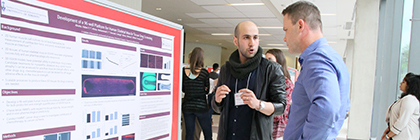
The Muscle Health Research Centre (MHRC) at York University hosted its eighth annual Muscle Health Awareness Day (MHAD8) on May 26, where researchers and students gathered to celebrate and learn about research in muscle health.
 The event, which explores “muscle health” in the broadest terms, including skeletal and cardiac muscle function during exercise, disease and development, attracted more than 120 faculty and student attendees, and featured 50 poster presentations from students and researchers – the most this event has had since its inception in 2010.
The event, which explores “muscle health” in the broadest terms, including skeletal and cardiac muscle function during exercise, disease and development, attracted more than 120 faculty and student attendees, and featured 50 poster presentations from students and researchers – the most this event has had since its inception in 2010.
MHAD provides a platform on which faculty members, graduate and undergraduate students, as well as post-doctoral fellows and other researchers can assemble, and this year featured invited talks from experts in these fields, as well as poster presentations from students and trainees in the MHRC and from other universities within Ontario and Quebec.
 Three separate symposia featuring invited speakers were held in between poster sessions. The first one, entitled “Bioengineering, stem cells and gene expression,” featured Milica Radisic from the University of Toronto, where she heads the Laboratory for Functional Tissue Engineering. She presented groundbreaking research regarding the engineering of a “heart-on-a-chip” and “vasculature-on-a-chip,” which are breakthroughs in tissue engineering and permit the testing of drugs and therapies on tissue in a laboratory setting.
Three separate symposia featuring invited speakers were held in between poster sessions. The first one, entitled “Bioengineering, stem cells and gene expression,” featured Milica Radisic from the University of Toronto, where she heads the Laboratory for Functional Tissue Engineering. She presented groundbreaking research regarding the engineering of a “heart-on-a-chip” and “vasculature-on-a-chip,” which are breakthroughs in tissue engineering and permit the testing of drugs and therapies on tissue in a laboratory setting.
Following this presentation, Vladimir Ljubicic of McMaster University, and formerly a graduate student of David Hood’s lab in the MHRC, presented recent data about the role of a specific family of proteins, the protein arginine methyltransferases (PRMTs), in mediating the response of skeletal muscle to exercise and inactivity.
Last in this session was Michael De Lisio from the University of Ottawa, where he operates the Exercise and Stem Cell Physiology Lab. De Lisio presented a combination of data from some recent publications which discussed the impact of exercise on stem cell function, while presenting some new information on the role of exercise and diet in modifying bone marrow adipose tissue.
In the second symposium, entitled “Muscle Physiology and Rehabilitation,” Chetan Phadke from the West Park Health Care Centre in Toronto presented data from his patients regarding the impact that strokes have on balance and muscle spasticity. Kei Masani of the University of Toronto then discussed novel methods of electrically stimulating muscle called “functional electrical stimulation,” and described the impact that this can have in the reduction of muscle fatigue, and its potential uses in muscle rehabilitation.
 The day ended following the third symposium, entitled “Cardiac, Vascular and Muscle Pathophysiology.” Kim Connelly from the Keenan Research Centre for Biomedical Science at St. Michael’s Hospital showed new data regarding work his lab has done on the protein α11 integrin in heart muscle, which appears to play a role in mediating the “cross-talk” between different cell types and compartments within the heart. Jefferson Frisbee of the University of Western Ontario presented data regarding microvascular and arteriolar dysfunction in metabolic syndrome, and had interesting thoughts on how this system may be better thought of in terms of “chaos theory.”
The day ended following the third symposium, entitled “Cardiac, Vascular and Muscle Pathophysiology.” Kim Connelly from the Keenan Research Centre for Biomedical Science at St. Michael’s Hospital showed new data regarding work his lab has done on the protein α11 integrin in heart muscle, which appears to play a role in mediating the “cross-talk” between different cell types and compartments within the heart. Jefferson Frisbee of the University of Western Ontario presented data regarding microvascular and arteriolar dysfunction in metabolic syndrome, and had interesting thoughts on how this system may be better thought of in terms of “chaos theory.”
The day ended with a presentation from Jonathan Schertzer, who discussed recently published data regarding the role of inflammation signaling in mediating myopathy related to the use of statins and aging.
Given the size of the event this year and the impressive lineup of speakers, along with the number of poster presentations provided by graduate student in trainees, this event was again a tremendous success.
For more information on the Muscle Health Research Centre and its upcoming events, visit mhrc.info.yorku.ca.
